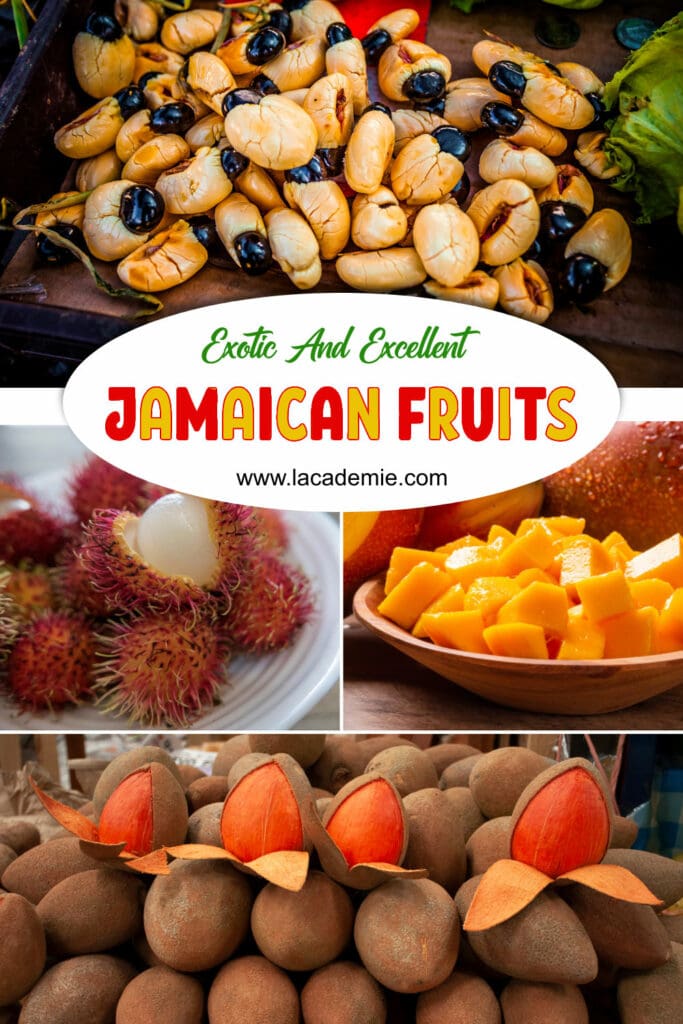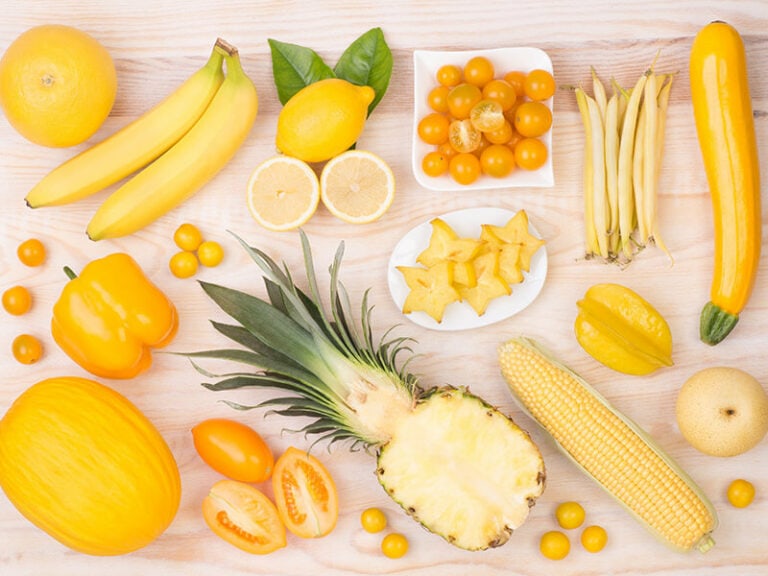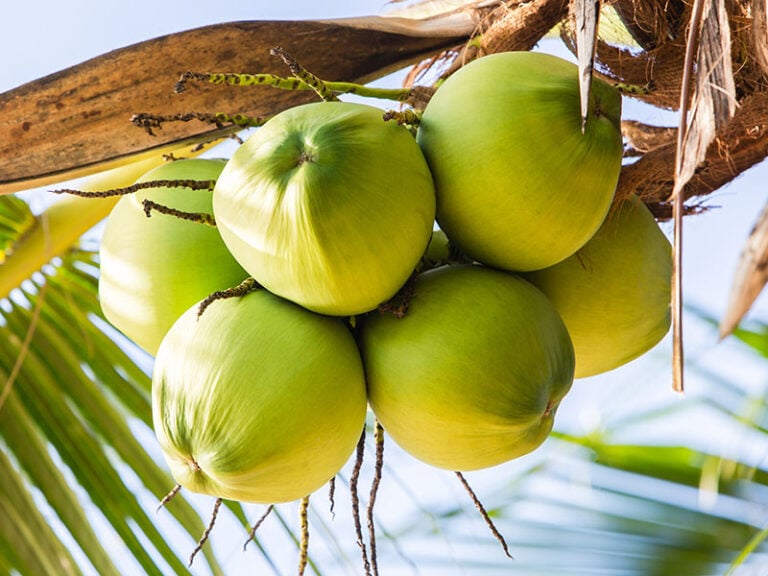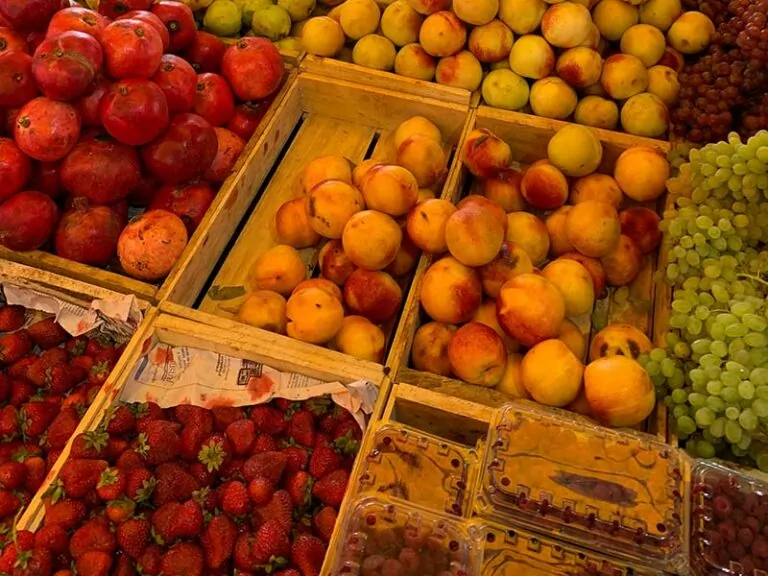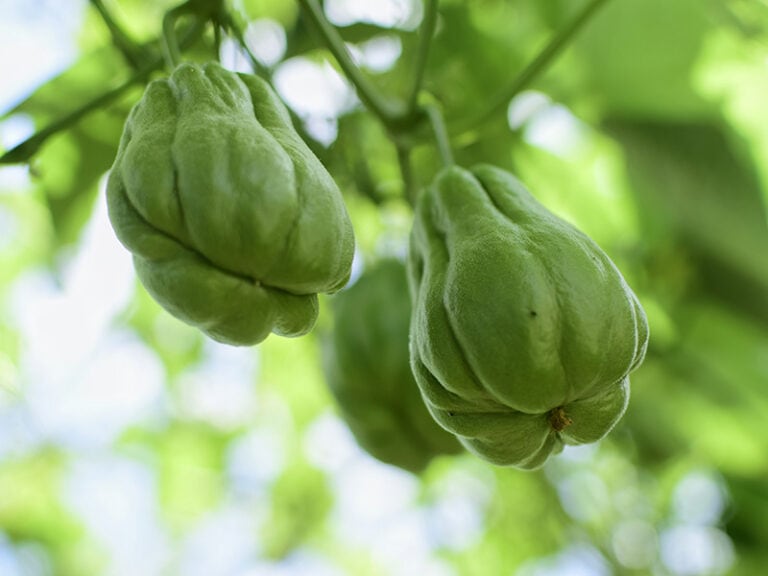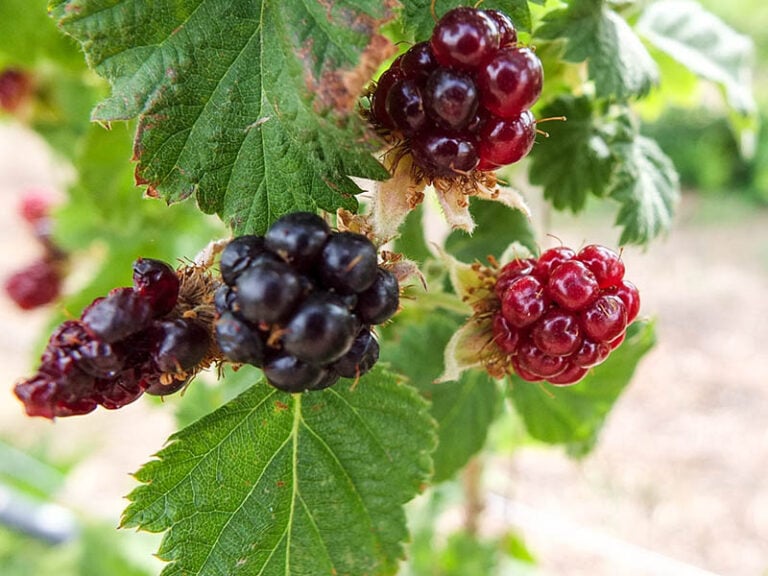Do not miss the chance to try the excellent Jamaican fruits in this post because their flavor will make you flutter. It is not difficult to find the taste of various fruit species in Jamaican recipes as fruits are an essential part of Jamaican cuisine that many people love.
This article is a rich source of fantastic fruits to diversify your choices after each party in Jamaica during your trip. Before getting the suitable selections, you should find out all the essential things about them. Let’s explore right away.
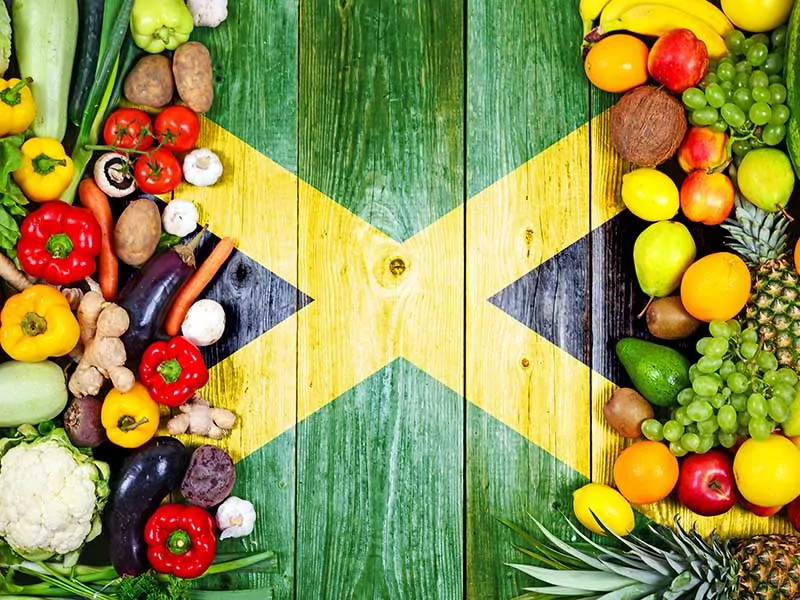
Mouthwatering Jamaican Fruits Containing Inedible Seeds
In this part, I will give you the Jamaican fruits you need to throw the seeds while consuming. Therefore, please pay more attention to ensure you eat them correctly for safe consumption.
1. Ackee
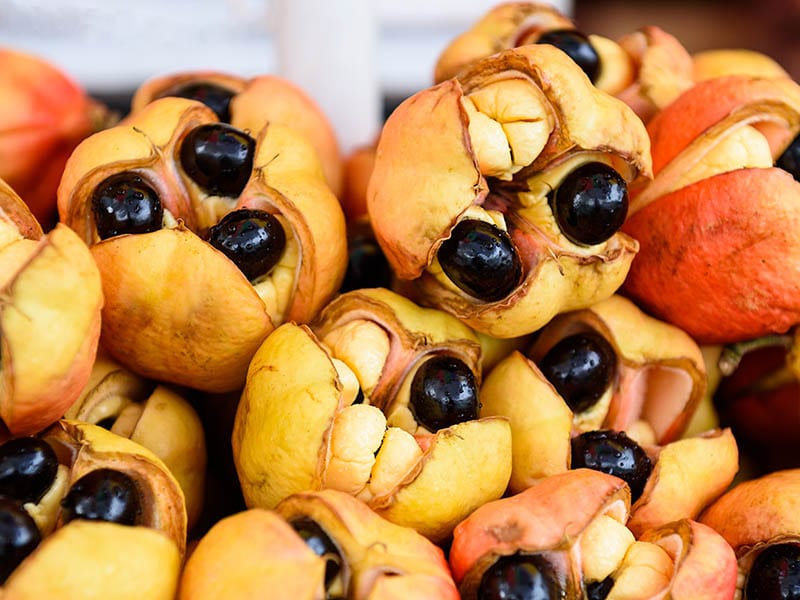
Ackee is a national fruit of Jamaica. And most people love to taste it after each meal. This fruit has its origin in West Africa, and it appeared in Jamaica in the 18th century. Nowadays, you can come across this fruit across the country.
You can think of the pear when you look at the shape of this well-known fruit starting with A. Usually, immature ackee will be green and turn red or yellow-orange when ripe. It contains 3 lobes, and each lobe has a white or yellow flesh with a creamy and spongy texture.
When breaking the fruit, there are 3 large and glossy seeds inside. This fruit is in the same family as lychee. Furthermore, ackee is a common ingredient in cooking in Jamaica. People often consume it in the morning and combine it with a buffet in this country.
Before being ready for collecting, ackee will open fully to discard the toxicity. You can consume the yellow aril when removing the seeds by parboiling it in salted water and frying it in butter to make a yummy dish.
Nutrients: Plenty of vitamin C, folacin, riboflavin, thiamine, and potassium.
Season: Its season runs from January to March and from June to August in Jamaica.
How to eat: You should never eat unripe (closed) ackee as it is poisonous. When the fruit fully opens, discard the seeds and the pinkish membrane (they’re also poisonous) and cook the yellow aril before eating.
Discover all things about ackee and the fantastic taste of this fruit.
2. Rambutan
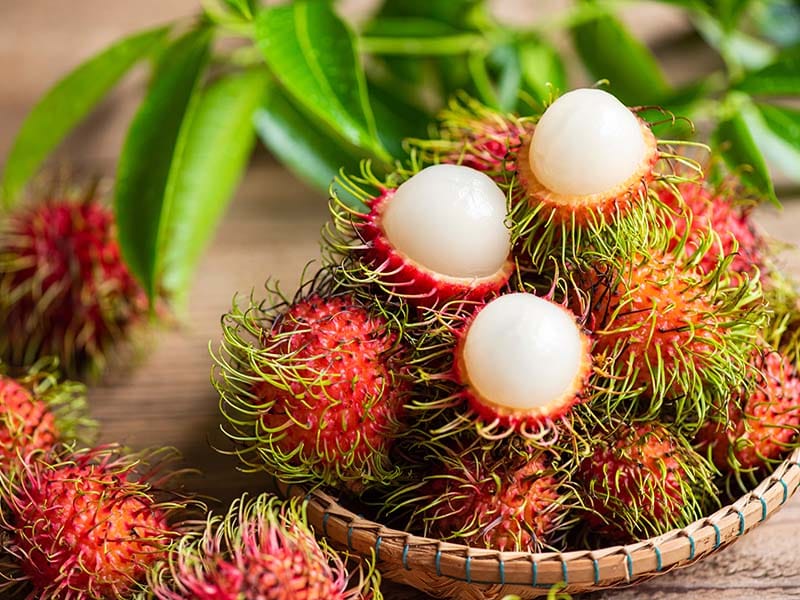
Although Southeast Asia is the homeland of rambutan, you can find this fruit widely in the Caribbean and Latin America. This fruit is a part of the Sapindaceae family, along with lychee, pulasan, longan, and mamoncillo.
It has a unique appearance with many fleshy pliable spines on the skin. You can imagine a head with a lot of hair. Its name comes from the “rambut” word, which means “hair” in Malay. It is a drupe fruit with an oval or round seed in the middle.
The leathery and reddish skin will captivate you at first sight. After peeling the skin, you can enjoy the succulent and whitish flesh. Its texture is similar to jelly, and the enchanting sweetness will make you flutter right away.
Moreover, you can feel a hint of acidity from this fruit that makes you think of grapes’ taste. It is easy to find this fantastic fruit in the local markets in Jamaica. People often consume fresh rambutan as a great snack in this country.
Nutrients: Rich in manganese, copper, vitamin C, potassium, folate, calcium, and vitamin A.
Season: Its season is in the late winter in Jamaica.
How to eat: To consume rambutan, you need to peel the skin and eat the flesh. Let’s remove the seed while eating.
3. Mango
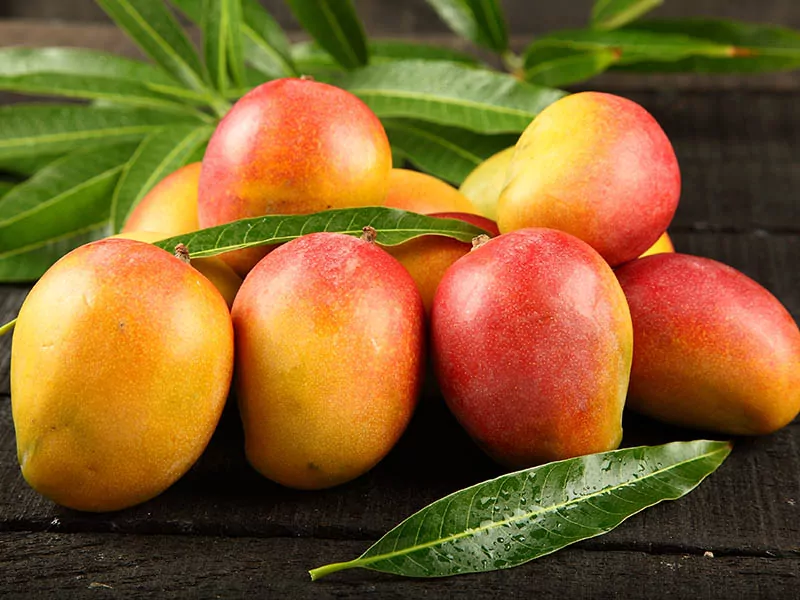
Mango is a fruit that you can see in many regions worldwide because it is well-known. It originates in Myanmar, India, and Bangladesh. This fruit existed over 4000 years ago. Jamaicans consider mango a local fruit of this country.
It is diverse in variety, with several types of mango globally. Therefore, this fruit has various colors, shapes, and sizes. Typically, mango is often found in round, oval, or kidney shapes.
When ripe, mango will turn from green to yellow, red, or orange. Moreover, it will not be crunchy anymore as the texture will become softer and creamier. It is hard to resist the charming fragrance of mango.
The sweet taste of mango’s red, yellow, pink, or orange flesh will make you fall in love immediately. In addition, a bit of sour flavor will tickle your taste buds at the first bite. In Jamaica, blue, Bombay, or emperor are the famous mango varieties.
Nutrients: Plenty of calories, fiber, protein, vitamin A, C, B6, and potassium.
Season: This fruit is often ripe from April to May and late July to August.
How to eat: Slice mango around the pit and cut slices on the flesh of this fruit. Push the portion up from the skin and consume its flesh.
4. Star Apple
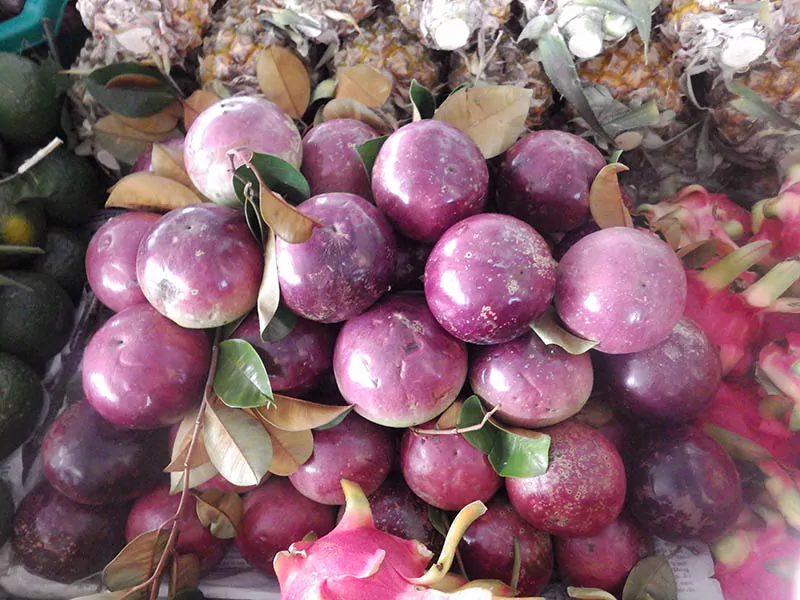
It is a pity not to mention star apples in this great list. This fruit is derived from the Isthmus of Panama and spreads to the West Indies, Greater Antilles, and Southeast Asia. It is called caimito, purple star apple, or milk fruit in many other regions.
It looks eye-catching in the deep purple skin and some green spots on the surface. You cannot consume the rind, but the white or yellow flesh is mouthwatering. Its pulp is soft, milky, and creamy with high water content.
You can see a star pattern in the flesh when cutting this fruit into 2 parts. Until now, I cannot forget the star apple’s excellent sweetness and delicate flavor. You can confuse the taste of kiwi and persimmon because they have some similarities.
In Jamaica, besides consuming fresh star fruit, people often mix it with sour orange juice to make delicious and unique juice for dessert. And the awesome recipe is called “matrimony”.
Nutrients: Rich in fiber, vitamin C, B5, folate, copper, potassium, and magnesium.
Season: This fruit is often ripe from March to June in Jamaica.
How to eat: Use a knife to chop it into 2 halves, remove the seeds and consume the flesh of this fruit.
Learn the ways to consume star apples properly.
5. Ortanique
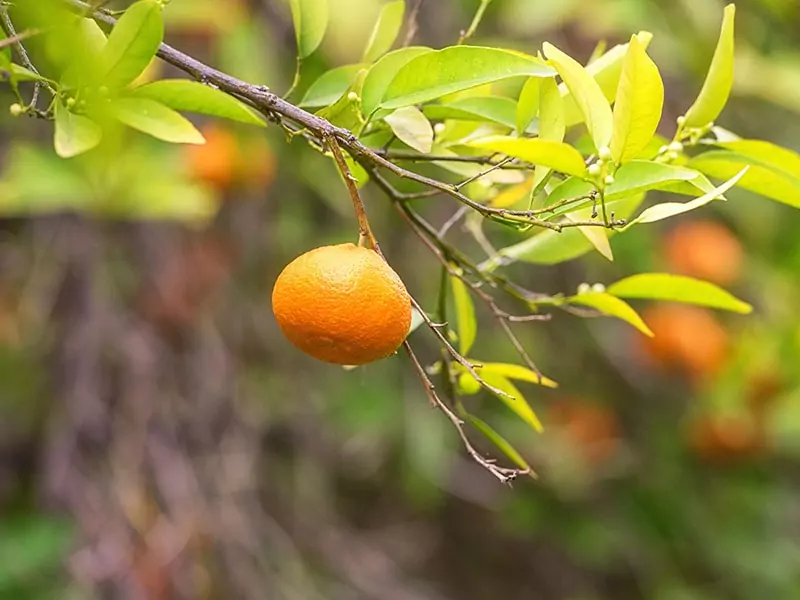
Tangor is another name for this fruit. It is a hybrid fruit between mandarin and sweet orange. Its name comes from 3 words, including “orange”, tangerine”, and “unique”.
In 1939, the Jamaica Agricultural Society (JAS) accepted David Daniel Phillips as the inventor of this O-something fruit. Its appearance is similar to mandarin with an orange or yellow thick rind. There are many succulent segments inside each fruit.
It is fantastic to enjoy the delicious sweetness of its bright orange flesh. In addition, a hint of sourness is an indispensable part of the citrus fruit. The most common method to eat it is consuming raw fruit or squeezing it to get the juice.
Nutrients: High in vitamin C, calories, carbs, sodium, and potassium.
Season: Its season lasts from February to April in Jamaica.
How to eat: You can consume its segment directly or squeeze the water to make juice.
6. Sweetsop
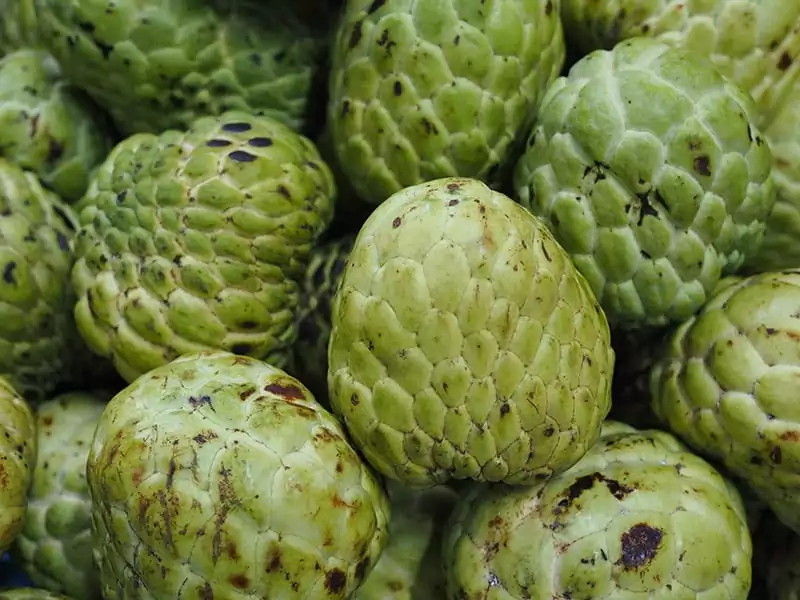
I guarantee that you will fall in love with the recipes containing sweetsop or sugar apple recipes in Jamaica. It is a favorite fruit of local citizens in this country. This fantastic fruit originates in the Americas and West Indies.
Sweetsop has a characteristic appearance with a spherical shape. When you touch the skin, you will feel strange because knobby segments create its skin. You can find it in the green or dark pink rind.
Inside the fruit, it is a group of numerous small segments, and each part will contain a tiny black seed. Sometimes, you can not see the seed inside the smallest segments. Its flesh has an appealing aroma and creamy texture.
People also call it “custard apple” because of the similarities in texture between this fruit and custard. The sweet taste of its white or yellow flesh will bring a fantastic experience when eating the raw fruit. In addition, you can find it in smoothies, fruit bowls, and other desserts.
Nutrients include vitamin C, B6, B2, B5, iron, magnesium, potassium, and phosphorus.
Season: Its season begins in April and ends in July in Jamaica.
How to eat: Separate sweetsop into 2 parts and scoop the flesh to consume. Please throw the seeds while consuming.
7. Jamaican Pear/Avocado
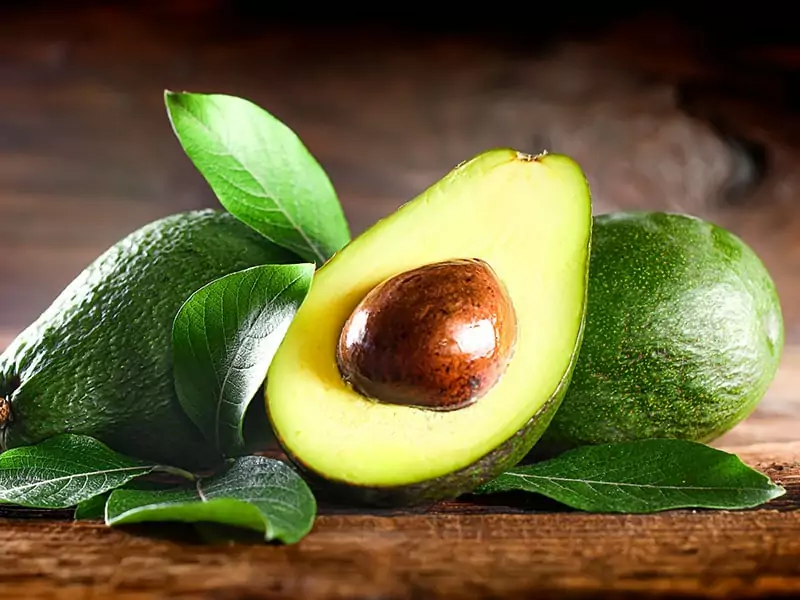
It is common to see avocado trees in the backyards of Jamaican houses. This fruit plays a crucial role in Jamaican cuisine. People often call the Jamaican avocado pear in this country because of the similarity in shape between an avocado and a pear.
Avocado is native to the highland lands in Guatemala and Mexico. Gradually, it is planted in Jamaica and many tropical regions worldwide. The avocado belongs to the Lauraceae family. A skin, buttery flesh, and an ample seed are the 3 main parts of this fruit.
There are many various cultivars of avocado around the world. This fruit is diverse in colors, shapes, and sizes, depending on the type. Typically, avocado often has a similar shape to egg and pear.
When ripe, avocado skin will have brown, green, black, or purplish colors. The pale green flesh with earthy and grassy flavor will make you flutter when eating. The buttery and creamy texture will bring a perfect consistency for smoothies.
Besides, the delicate flavor of this fruit is suitable for making salads or dips. You can combine this fruit with meat and seafood dishes.
Nutrients: Rich in fiber, healthy fats, vitamin E, C, B6, magnesium, folate, and potassium.
Season: This fruit is often ripe from August to December in Jamaica.
How to eat: The best way to use avocado is to slice it into 2 sections and remove the pit inside. Get the flesh with a spoon to consume.
8. Sour Orange
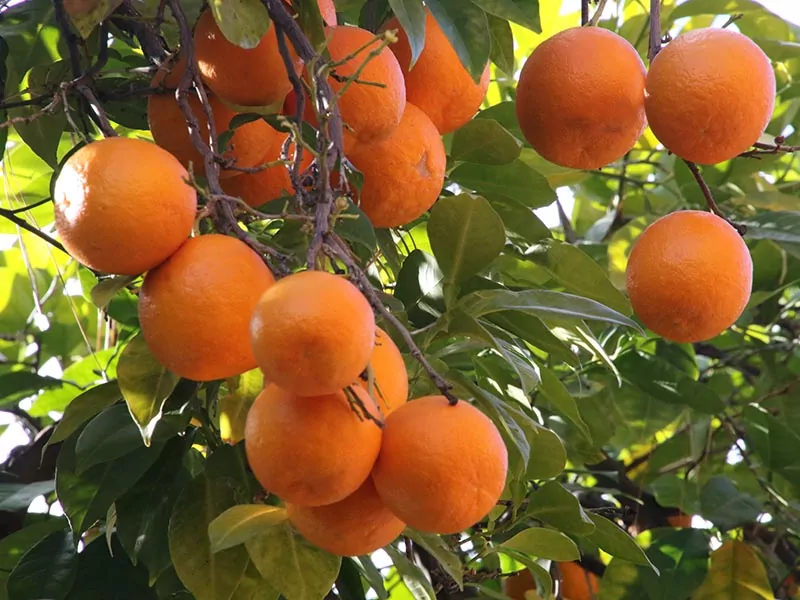
Sour orange, bitter orange, or Seville orange is the popular citrus fruit in cooking in Jamaica. Also, you can feel its taste in Cuban and incredible Mexican dishes. This excellent fruit has its origin in Southeast Asia.
In the Americas, this fruit is found in Florida and the Bahamas. And it started spreading widely globally when people cultivated this fruit in the 10th century. Sour orange is a hybrid achievement between mandarin orange and pomelo.
Sour oranges look like other common oranges with an orange or yellow color. It includes many juicy segments inside. However, it will be sourer than other oranges, and the flavor is more intense. So, it is rare to be consumed raw.
You can enjoy the fantastic taste of orange marmalade, liqueurs, or jams. The pickled orange and yogurt combination in Thayir Sadam (spiced yogurt rice) will bring outstanding taste. Moreover, Jamaicans often mix the peel with syrup to create a Christmas dessert.
Nutrients: High in vitamin C, calories, carbs, fiber, and protein.
Season: Its season runs from late December to mid-February in Jamaica.
How to eat: The natives often cut the fruit into small slices and squeeze the juice to marinate many delicious recipes. In addition, it is good to use its rind in many desserts to bring out the citrus note.
9. June Plum
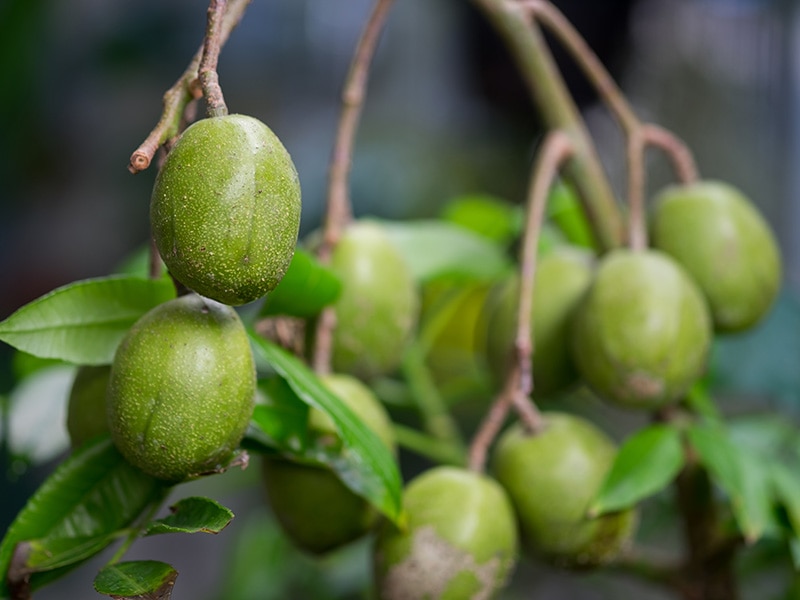
June plum appeared in Jamaica in the late 1700s, and it is used commonly in Sri Lanka and Indonesia in sweet and savory dishes. People often call it the “golden apple” in many English-speaking countries.
It is simple to acknowledge this fruit with the oval shape and green or golden-yellow colors. Typically, you will see a bunch of 12 or more June plums on the tree. The crunchy texture of unripe June plum will not let you down.
When ripe, the texture will become softer, and many locals love to suck the pit clean or chew it because the tender consistency of the pit will allow you to do it.
The combination of sweet and tart flavors is suitable for making fabulous Jamaican drinks, preserves, and desserts. Moreover, you will be addicted to the taste of plum when consuming it with salt or mixing it in stews.
Nutrients: It has vitamin A, B, C, K, protein, calcium, magnesium, and phosphorus.
Season: Its season extends from September to mid-January in Jamaica.
How to eat: Peel the thin skin of June plum and eat the flesh around the stone.
10. Soursop
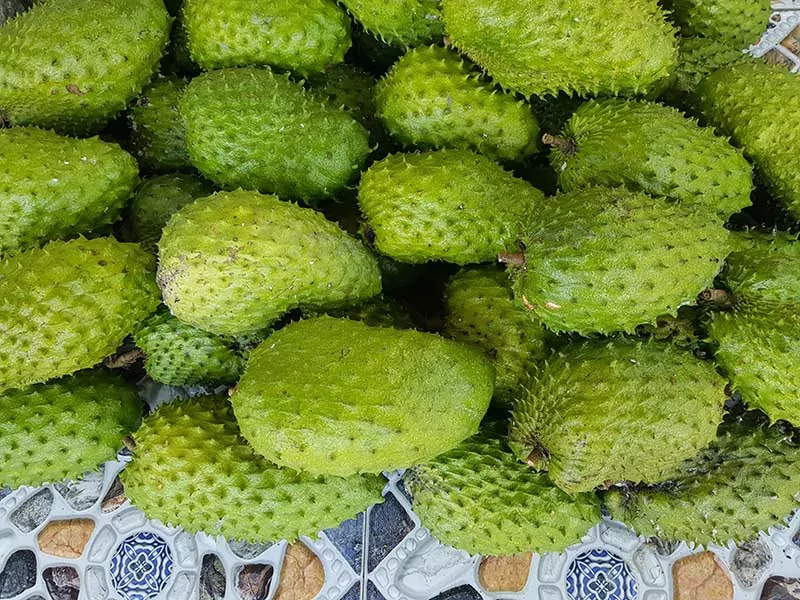
Until now, I still want to come back to Jamaica to taste the typical flavor of soursop because it left a deep impression on my mind on my last trip. Soursop often appears on the menu of Jamaican desserts. It is derived from the Caribbean and the Americas.
It is not complicated to recognize soursop because it has a typical appearance with deep green and prickly rind. When touching the soursop from the outside, you will feel the firm texture. However, the creamy and soft texture will fascinate you after breaking this fruit.
You will want to enjoy the juicy and white flesh of soursop immediately. Its fantastic and charming aroma will kill you right away. You cannot wait to consume smoothies, juices, candies, sorbets, and ice cream made from this fruit.
Nutrients: Rich in calories, sodium, carbs, fiber, vitamin C, and protein.
Season: Its season extends from November to March in Jamaica.
How to eat: To get the flesh inside to consume, you should cut it into 2 sections. Please remove the seeds while eating.
Follow these instructions to make Jamaican soursop juice.
11. Mammee Apple
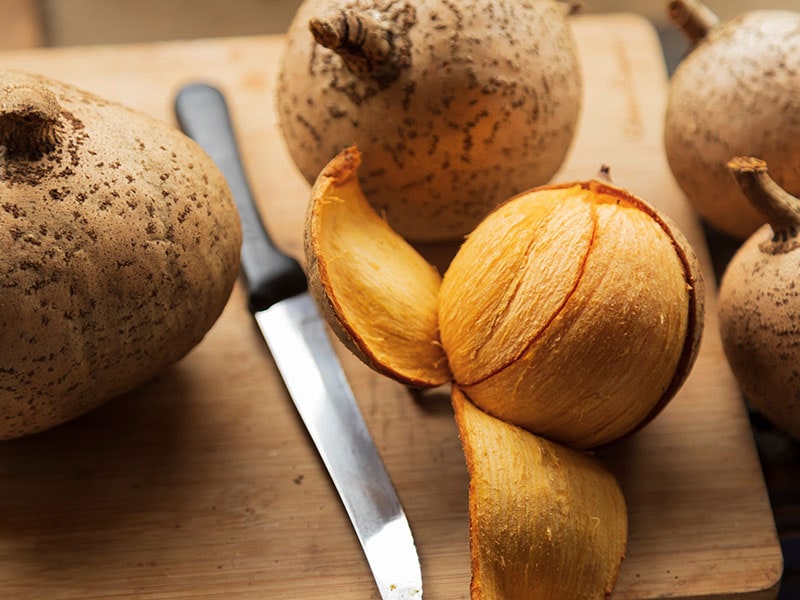
It is easy to confuse this fruit with mamey (a popular Cuban fruit), but there are 2 different types of fruit. Mammee apple is a popular fruit in Jamaica and South America. You can call it the Santo Domingo apricot or South American apricot.
And in Central America, it is also known as mamey Amarillo and yellow mamey. This fruit is a berry, although it has a stone in the center. It has a rustic appearance with a grey-brown rind. The rind is the combination of exocarp and mesocarp.
The delicious pulp of this fruit is created from the endocarp layer. Its flesh is often yellow or orange and has a crispy and juicy texture. The pleasant smell of its flesh will awaken you immediately. You can think of the flavor of apricot while consuming this fruit.
There are many fantastic ways to use mammee apples. Commonly, Jamaicans often consume fresh fruit. Furthermore, it is a common ingredient in preserves and stews.
Nutrients: A source of calories, protein, carbs, fiber, vitamin C, and phosphorus.
Season: It is often ripe between July and October.
How to eat: Slice in half and remove the seeds of this fruit. Scoop the flesh with a spoon.
12. Otaheite Apple
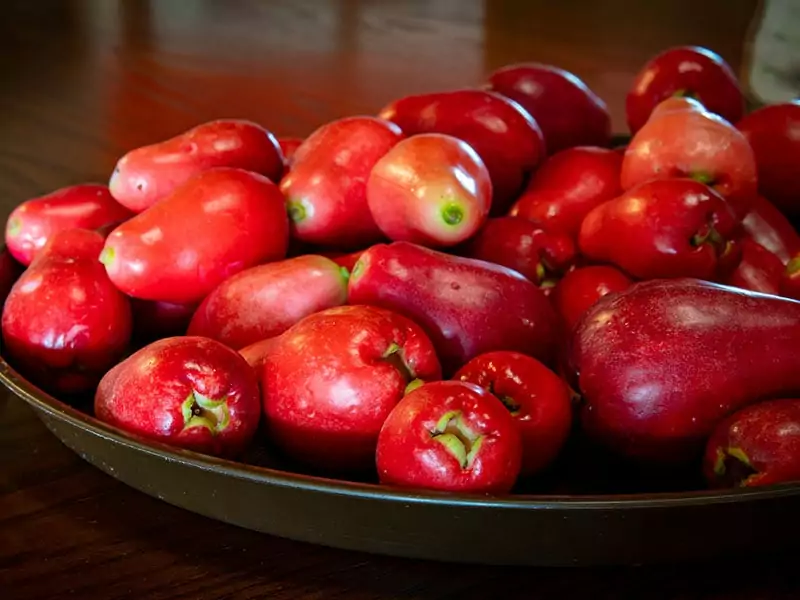
Otaheite apple is a long-standing fruit that has existed since prehistoric times and is associated with Austronesian peoples. Nowadays, this fruit is common in Cuba, Jamaica, and other countries throughout the Caribbean and the tropics.
Besides the Otaheite apple name, you can call it Malay rose apple, coco plum, Ethiopia apple, or mountain apple. You can remind of an apple and pear because this fruit has the same red color and shape as apple and pear.
Occasionally, you can see apples belonging to many different species. Almost Otaheite apple has white and spongy flesh, and it contains a seed in the middle. This fruit tastes mild, and you can think of the flavor of a pear when eating the Otaheite apple.
In Jamaica, Captain Wiliam Bligh produced this fruit first in 1793. You can consume the raw fruit to enjoy the authentic flavor of the fruit. In addition, making jam by cooking this fruit with ginger and sugar is an ideal choice.
Nutrients: You can find calcium, iron, vitamin A, C, B, fiber, phosphorus, and flavonols in this fruit.
Season: Its season lasts between August and September in Jamaica.
How to eat: Discard the rind of the apple and slice it into 2 sections to take the seed out. Cut the fruit into small pieces to consume.
13. Tamarind
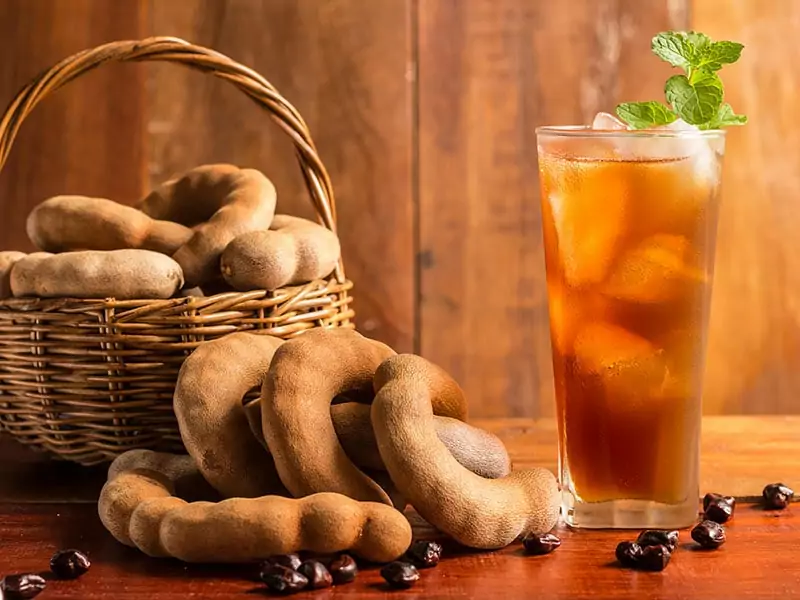
Tamarind is a popular ingredient in the cuisine of many countries globally. So, you also catch this fruit in many Jamaican dishes. This famous fruit comes from the tropical regions of Africa. Today, this fruit is planted in many tropical areas worldwide.
To consume the pulp inside, you have to remove the green or brown pod. The tamarind pulp will bring a tangy and sweet flavor to your foods. Each pod contains about 6 to 12 seeds, and the pulp will cover each seed.
This fruit is a rich vitamin C, calcium, and tartaric acid source. If you are good at consuming sour fruit, you can eat raw tamarind. Moreover, it appears in many savory dishes to diversify the taste. Tamarind jams or paste are essential elements in cooking.
Nutrients: High in calories, protein, carbs, fiber, and vitamin C.
Season: The tamarind season in Jamaica runs from January to March.
How to eat: Break the pod of tamarind. Eat the sour flesh from the seeds.
Go to the kitchen to make delicious Jamaican tamarind juice for dessert.
14. Naseberry
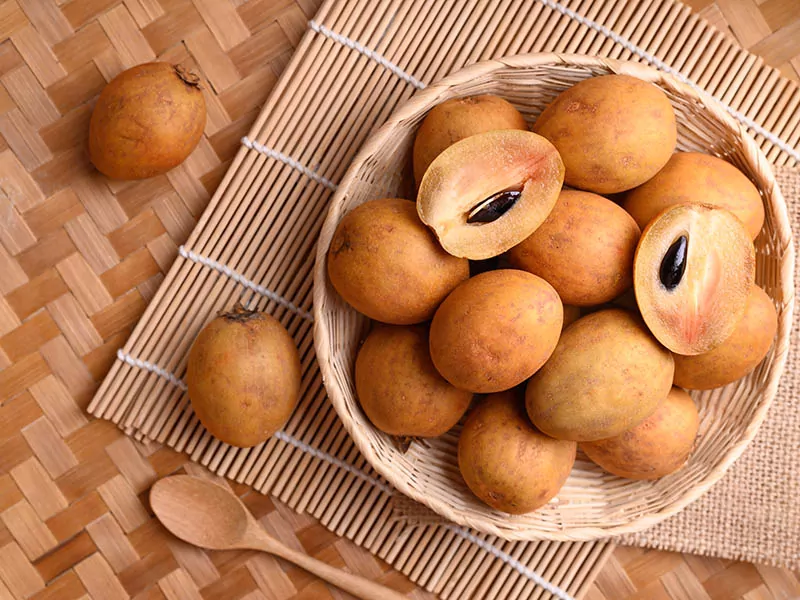
People also call it chikoo, sapota, or sapodilla. This fruit is an essential part of the daily diet of Jamaicans because they love to consume it after each meal to refresh their taste buds. This delicious fruit is native to the Caribbean, Mexico, and Central America.
Naseberry looks rustic in the pale yellow or earthy brown color when ripe. You will immerse yourself in the grainy, soft, and smooth texture of this fruit. You can find about 1 to 6 seeds inside each fruit.
It is hard to resist tasting the sweet and malty taste of naseberry. The perfect taste and distinctive texture will conquer you on the first try. However, the unripe version is unpleasant because it contains astringent that can dry out your mouth.
Nutrients: High in vitamin C, antioxidants, calcium, and magnesium.
Season: Its season lasts from February to May in Jamaica.
How to eat: Cut this fruit into 2 parts, remove the seeds and consume its flesh with a spoon.
15. Chayote
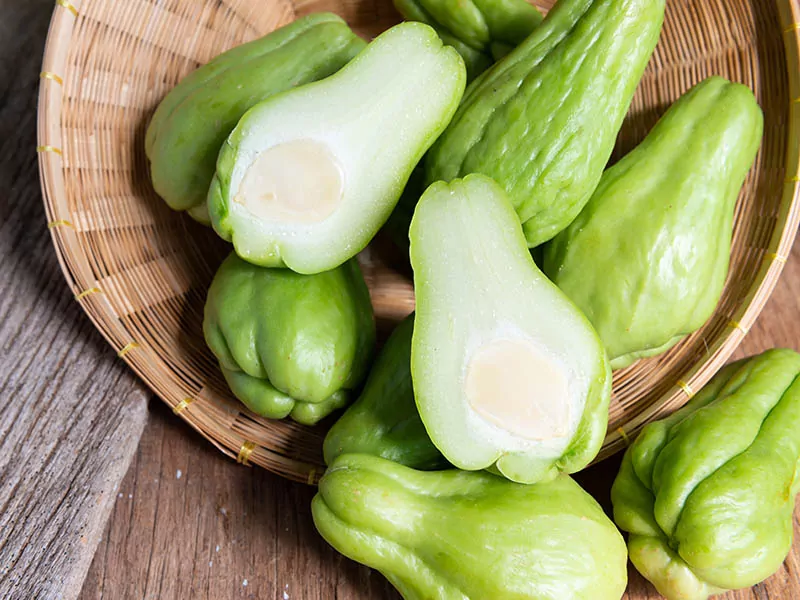
Chayote is a name I must mention in this list. Maybe, you can confuse this fruit as a vegetable, but it is a fruit. Also, you can know it as chocho or mirliton squash. Chayote cultivation happens commonly in Mexico, Jamaica, Honduras, and Latin America.
It looks like a pear because they are the same in shape. You will love the freshness of this fruit with green and glossy skin. It has crunchy white flesh with a large pit in the center. The texture can remind me of the combination of cucumber and potato.
Thanks to the mild flavor, Jamaicans often use it in cooking. Its crispy texture is compatible with making salsas or salads. Moreover, you can feel its taste in stews, stir-fries, soups, and other savory dishes.
Nutrients: Rich in antioxidants, vitamin C, calcium, manganese, and potassium.
Season: Its season extends from October to March in Jamaica.
How to eat: Peel the skin of this fruit, and slice it to remove the seed before using. Although you can eat chayote raw, it is mainly used for cooking.
Expand your knowledge with some correct ways to use chayote.
16. Lychee
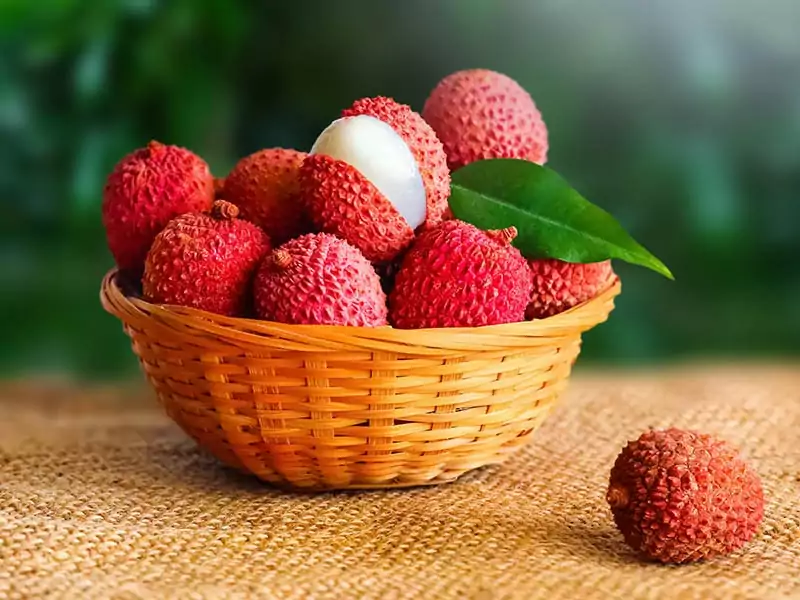
Lychee is a famous tropical fruit. This option originates in China’s Fujian, Guangdong, and Yunnan provinces. Gradually, the cultivation spreads to many other tropical regions globally, such as Southeast Asia, the Caribbean, and South America.
Its shape is diverse, from oval to heart-shaped to round. You cannot see its delicious flesh because it is protected by harsh red or pink skin. There are many tiny sharp protuberances on the surface of its skin.
To reach the white and juicy flesh inside, you need to break the shell. You will smell the floral aroma from ripe lychee. Its sweet and delicate flavor will make you want to consume more and more lychee.
Like longan, it contains a black or brown seed in the middle. To use lychee, you can consume it fresh or dry this fruit. Also, Jamaicans add this sweet fruit to many delicious desserts.
Nutrients: High in calories, protein, carbs, fiber, vitamin C, and calcium.
Season: This country’s season lasts from late June to late August.
How to eat: The easy way to consume lychee is to remove the shell and eat the meat around the stone.
17. Longan
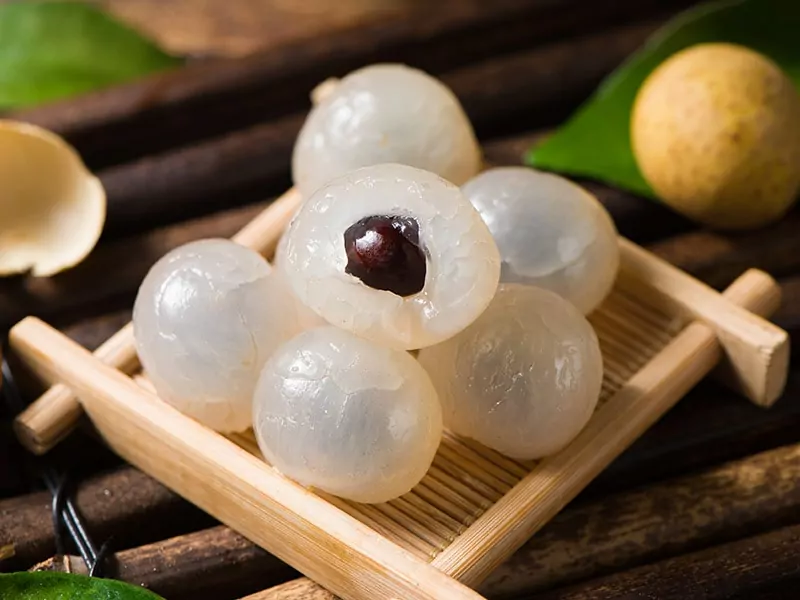
Longan is an iconic member of the Sapindaceae family. This fruit has a relationship with lychee and rambutan, so their structures are similar. Like rambutan, this fruit contains 3 parts: thin skin, juicy flesh, and a round pit.
Although longan is derived in China and tropical Asia, it is a preferred fruit of Jamaicans. It is known as the “dragon’s eye” because its round and black stone are similar to the eye of the dragon. You can peel the thin and firm brown skin easily with your fingers.
After breaking the skin, you can suck the fruit’s succulent and musky sweet flesh. Its flesh texture resembles jelly, and you should remove its seed while consuming. After each meal, Jamaicans will use longan as a fresh and delicious fruit dessert.
Nutrients: Rich in vitamin C, iron, phosphorus, magnesium, vitamin A, and potassium.
Season: July to August is the best time for harvesting longan in Jamaica.
How to eat: Break the skin with your fingers and suck the flesh to eat. Remember to remove the pit in the center.
18. Papaya
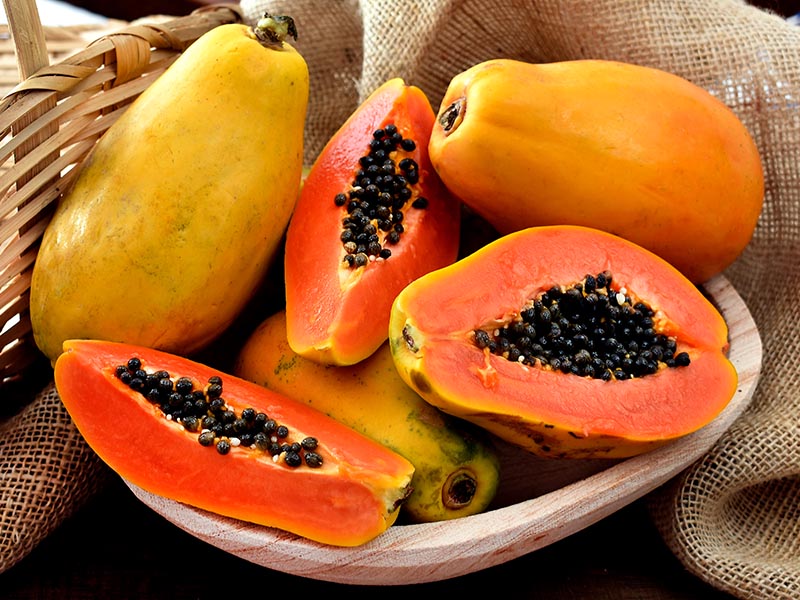
Papaya is a crucial fruit in Jamaican cuisine when it often appears in the fruit salad for breakfast in this country. Christopher Columbus called this fruit “the fruit of the angels”. This delicious fruit has its origin in the West Indies and South America.
You can try multiple kinds of papaya with different sizes and shapes. Almost papaya has round, elliptical, or pear-like shapes. Immature papaya is green and crunchy. But, it will turn yellow or red when ripe. The texture will become soft, smooth, and creamy.
If the unripe papaya has a mild flavor, the mature version will be sweet and has the same taste as melon or mango. In the center of papaya, you can find numerous tiny and bitter seeds. Solo Sunrise papaya is the most famous variety in Jamaica.
This type often includes orange-red flesh and sweet flavor. You can use papaya in many ways. The sweetness of papaya juice, puree, jams, or smoothies will not let you down. Unripe papaya often appears in salads, stews, and savory dishes.
Nutrients: A source of calories, sodium, carbs, fiber, protein, and vitamin A.
Season: Its season runs from June to September in Jamaica.
How to eat: Dice papaya into 2 sections and get the flesh with a spoon.
Let’s make mouthwatering drinks from sweet papaya.
Satisfy Your Mouth With Jamaican Fruits With Edible Seeds
In this special section, I would like to introduce a list of fruits containing edible seeds to you. You can consume their seeds directly or after boiling, toasting, and cooking.
19. Guinep
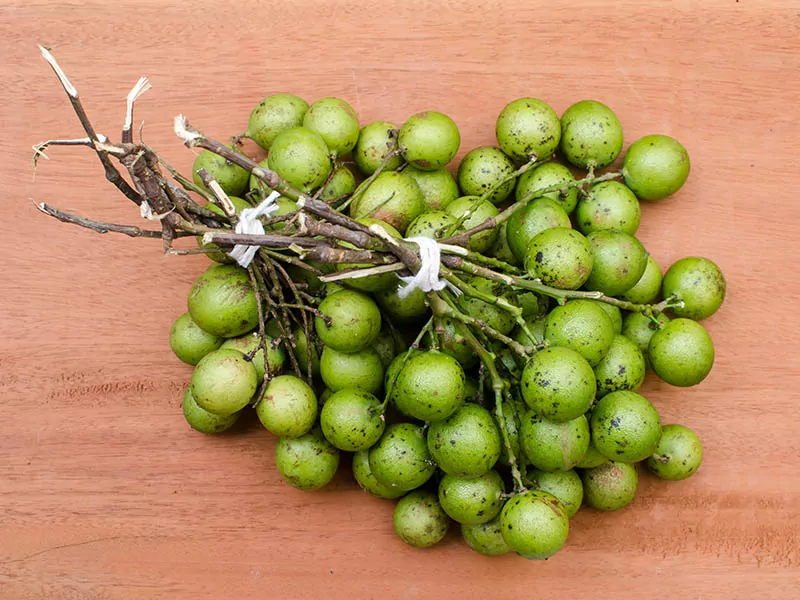
Guinep is a soapberry and belongs to the Sapindaceae family. This fruit originates throughout the New World tropics. Therefore, it is simple to purchase this fruit in the Caribbean, Central, and South America. It is also known as Spanish lime, limoncello, mamoncillo, or ackee.
Guinep is beloved in many countries. It’s among the most popular fruits in Haiti. There is a National Genip Fruit Festival in Puerto Rico, so you can participate when coming here. Overall, most natives and tourists love this fruit when traveling to Jamaica.
It is a drupe fruit with a single seed in the center. You can break the thin and green skin of this fruit easily. After removing the skin, the juicy and orange flesh will appear. You can suck the meat to feel the jelly-like texture and the characteristic taste of this fruit.
If you love the exceptional bittersweet, this fruit is a good choice for you. Sometimes, you can feel a bit of wine flavor while tasting this fruit. Do not forget to throw the seed. You can try fresh or canned guinep. But if you want to eat its slippery stone, you need to roast it before using.
Nutrients: You can add protein, carbs, fiber, calcium, phosphorus, iron, and vitamin C to your body.
Season: Its season begins in August and ends in October in Jamaica.
How to eat: Peel the rind of guinep and suck the flesh of this fruit to eat and remove the seed.
20. Guava
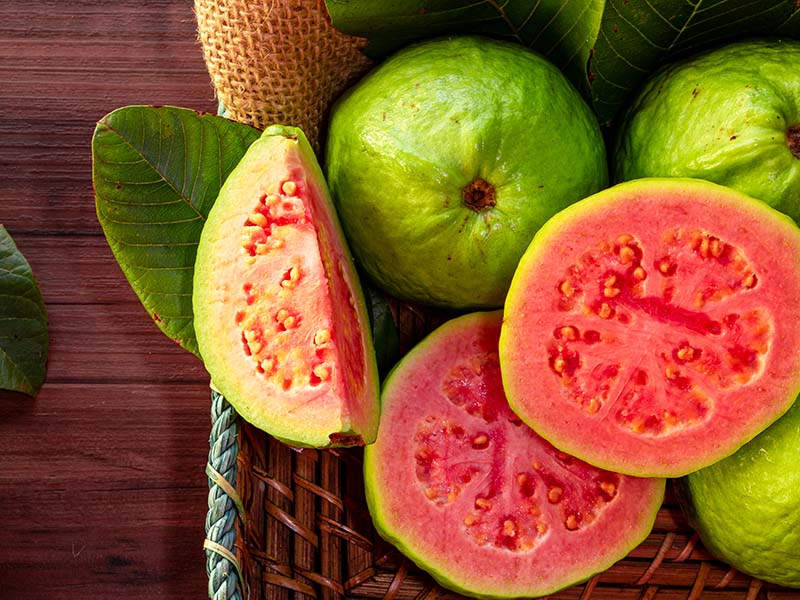
Guava is a common fruit that appears in many delicious Jamaican foods. It is an international fruit as you can come across it in many parts worldwide. This fruit is native to Central America, Mexico, South America, and the Caribbean.
There are various guava classifications, but the apple guava is the favorite variety globally. Guava is diverse in color, from yellow and green to maroon. Beneath the thin and edible skin, you will love this fruit’s white or deep pink flesh.
The ripe guava will bring an appealing fragrance and wonderful sweetness. Besides, a bit of sour taste will get the balance in flavor when tasting. You can see numerous hard and tiny seeds inside the fruit.
Jamaicans love the refreshing glass of guava juice on summer days. Moreover, they create guava paste to consume with salty cheese. You will fall in love with the fantastic taste of guava cheese, jams, or fudges.
Nutrients: High in calories, carbs, fiber, protein, vitamin C, and potassium.
Season: Its season extends from August to October and February to March in Jamaica.
How to eat: Peel the skin of guava with a knife and consume the fruit from the flesh to the seeds.
21. Pineapple
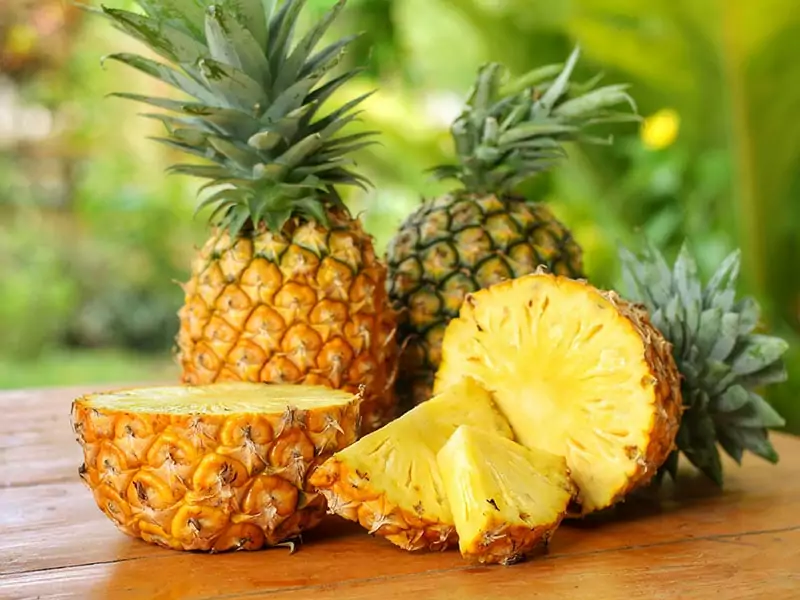
When speaking of the famous Jamaican fruits, I have to talk about pineapple. This unique fruit belongs to the Bromeliaceae family and is native to South America. The Tainos introduced the pineapple to Jamaica.
They were a group of people who came from South America and lived in Cuba and other Caribbean islands for the first time. Pineapple plays an essential role in the cuisine of Jamaica and many other countries in the Caribbean.
You can recognize pineapple easily, thanks to the unique rind. There are many hexagonal units on the surface of this fruit. You will immerse yourself in the juicy and sweet flesh inside. Besides, it looks eye-catching in the bright yellow.
In Jamaica, you can see 4 different sorts of pineapple, including cowboy, smooth cayenne, Ripley, and sugarloaf. Jamaicans love to refresh their taste buds with a glass of pineapple juice. Moreover, it appears in salads, drinks, smoothies, jams, and other desserts.
Nutrients: Vitamin B6, C, thiamin, riboflavin, magnesium, potassium, and manganese.
Season: This fruit is often matured between May to July in Jamaica.
How to eat: Remove the rind of pineapple with a knife and cut this fruit into small pieces to eat.
22. Almond
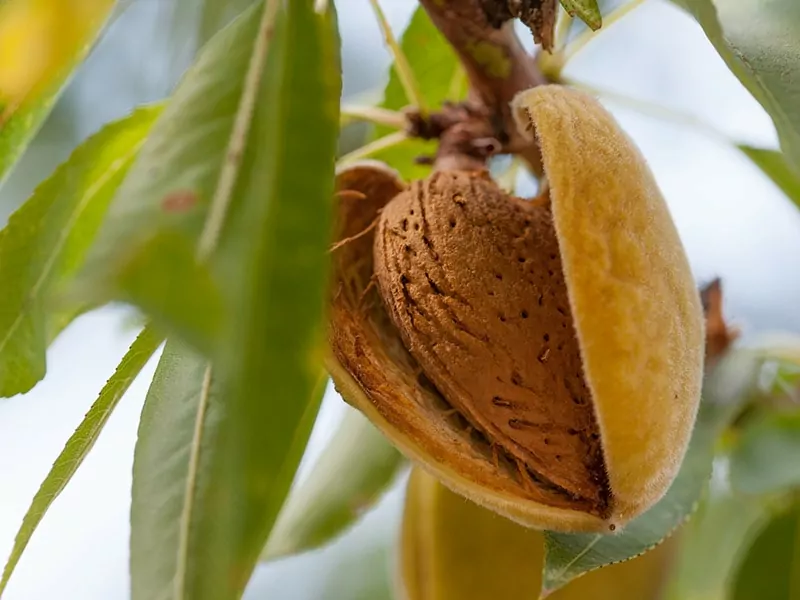
Have you ever tried dishes made from almonds? Let’s do it when coming to Jamaica. It is one of the most popular fruits in this country as you can find it easily in many regions across the country. This fruit is native to Iran and the Levant area in ancient times.
This fruit is a drupe and belongs to the same family as the peach. This fruit includes 3 parts, a green hull, a hard shell, and a seed in the center. You can find shelled or unshelled almonds selling commonly at supermarkets and stores in Jamaica.
People often consume raw almonds or toast them before eating. You can catch it in many delicious Jamaican recipes. It is possible to buy almonds in many forms, from whole fruit to slivered and grounded forms.
Nutrients: A source of vitamin E, riboflavin, fiber, phosphorus, and magnesium.
Season: This fruit is common in the summer in Jamaica.
How to eat: To eat almonds, you will need a knife to crack the fruit and consume the white pulp inside.
Listen to the incredible benefits of eating almonds.
23. Cacao
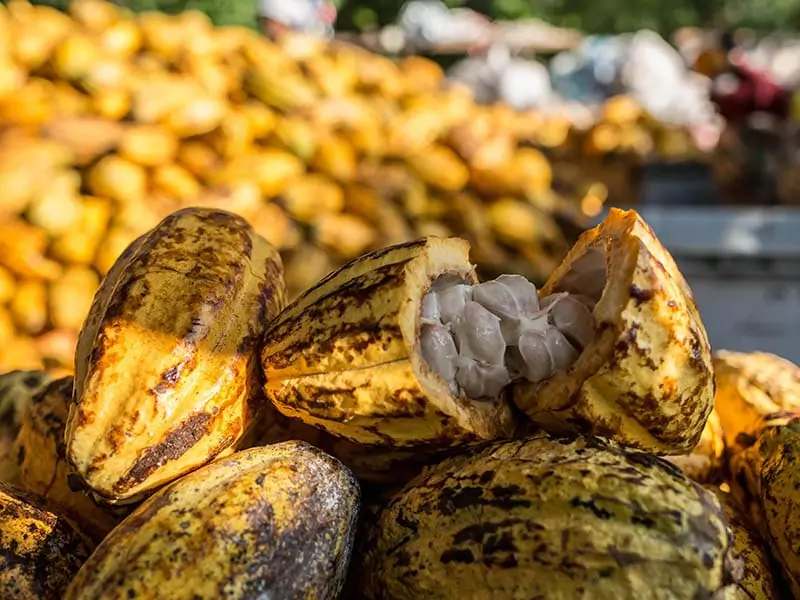
If you are a fan of chocolate, you will love the fantastic taste of cacao. It is also a famous Costa Rican fruit. This renowned fruit has its origin in the Amazon rainforest. It is a long-standing fruit in the Americas.
Its cultivation took place 5300 years ago, and people started using this fruit 4000 years ago in Yucatan. There are 3 different types of cacao such as criollo, trinitario, and forastero. A pod protects this fruit.
When mature, cacao will have yellow or orange skin. You can find about 20 to 60 seeds inside each pod. A white pulp will cover each seed. People will use the pulp to make juice, jelly, cream, and smoothies.
Meanwhile, the seeds are an indispensable element in making famous chocolate. You will feel this fruit’s sweet and tangy taste before processing it to make chocolate.
Nutrients: A rich source of calories, carbs, fiber, protein, and iron.
Season: Its season runs from May to July and from October to March.
How to eat: You will put the seed into your mouth and consume the pulp around the seed.
24. Blim Blim
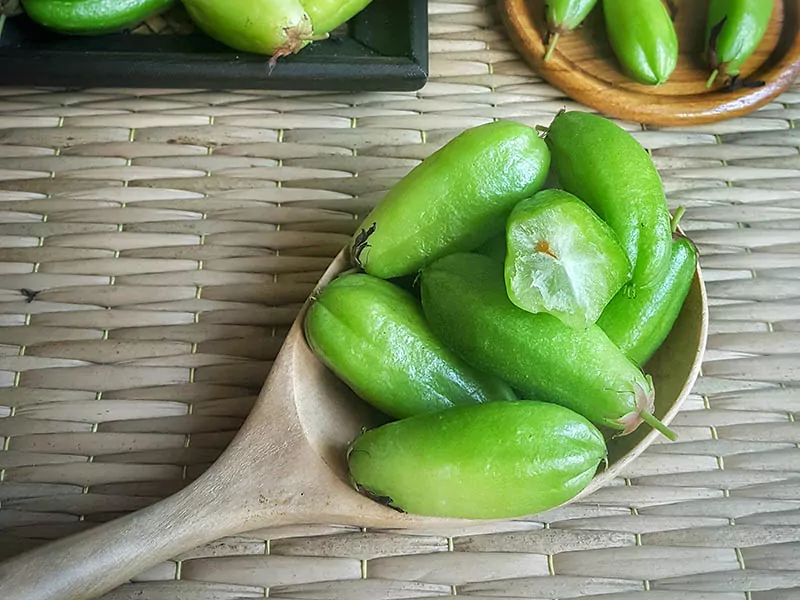
Blim blim deserves to appear on this list because of its popularity in Jamaica. This fruit is cultivated commonly in Jamaica, the Caribbean, and Guyana. Malaysia and Indonesia are the homelands of this unique fruit.
Blim blim has a near relation with star fruit, so you can notice five sides at the ends of the fruit. Besides blim blim, you can call it kamranga, gimblelin, coolie jimbelin, souri fruit, sour barge, sowry fruit, or tree sorrel. You will be impressed by blim blim’s smooth green or yellowish-green skin.
It looks glossy because a waxy layer covers it. Blim blim is an ideal option if you love to consume fruit with a crunchy texture. In particular, Jamaicans do not want to consume raw blim blim because of its high acidity.
Normally, Jamaicans will pickle this fruit or consume it with salt to reduce its sourness. In addition, it is used in many savory and sweet dishes.
Nutrients: Plenty of vitamin A, C, potassium, calcium, and magnesium.
Season: This fruit is common in Jamaica all year round.
How to eat: Let’s peel the fruit’s rind and eat its flesh. In particular, its flesh is suitable for cooking, and it is rare to be eaten raw.
25. Honey Banana
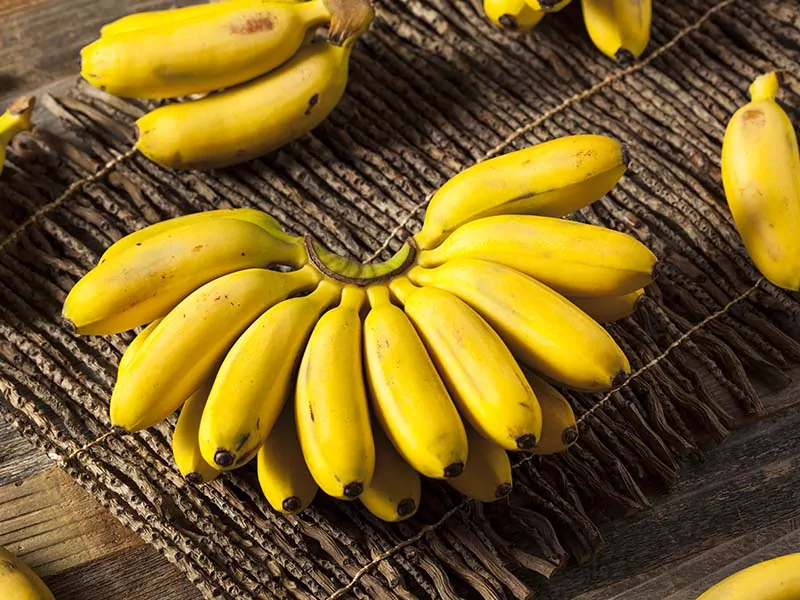
There are various kinds of bananas, and honey banana or baby banana is one of the iconic fruits of Jamaica. Jamaica is the first country that produces bananas as a commercial product. Compared to the ordinary Cavendish bananas, this version is shorter and sweeter.
Its color ranges from light yellow to reddish when ripe. After removing this fruit’s thin and leathery skin, the aromatic, sweet, and white flesh will show up in front of your eyes. It is also known as finger bananas because its appearance is similar to a hand with 10 to 20 fingers.
There are about 10 to 14 hands attached to a bunch. In Jamaica, people usually consume fresh bananas. Furthermore, you can find this excellent fruit in smoothies, fried snacks, and delicious Jamaican desserts.
Nutrients: It contains vitamin A, B1, B2, B3, C, iron, and magnesium.
Season: This fruit is available all year round in Jamaica.
How to eat: To consume a banana, you need to remove the fruit’s rind and devour the flesh.
26. Jackfruit
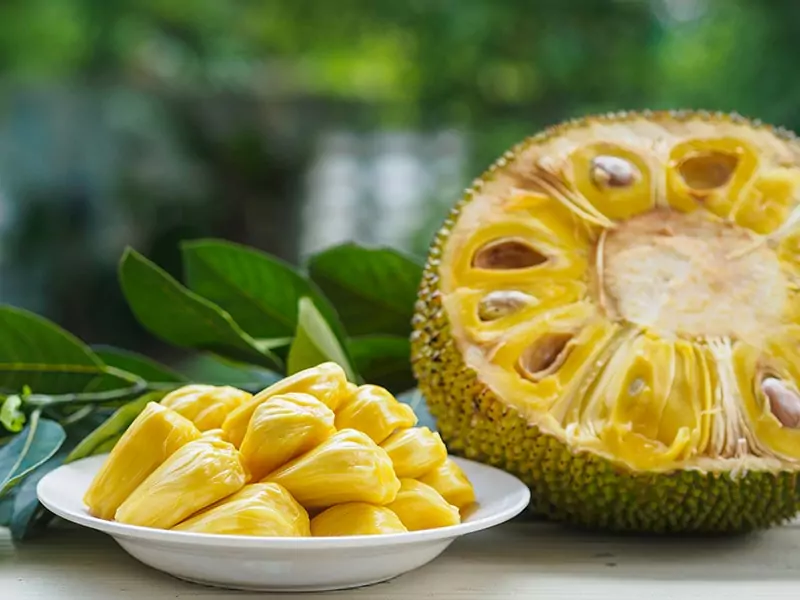
If you love vegan foods, you can come across jackfruit regularly. Jamaicans often take advantage of the starchy flesh of jackfruit to make praised dishes. In addition, you can add it to meat and seafood recipes.
Moreover, you can use it for many purposes with ripe jackfruit. Commonly, consuming fresh jackfruit is the fastest way. You can prepare jams, juices, pies, dried snacks, and other sweet treats from jackfruit.
Jackfruit is cultivated in Western Ghats, Sri Lanka, and Southeast Asia for the first time. It is a large fruit, weighing from 22 to 55 pounds. The yellowish-greenish or yellowish-brown rind will protect the bright yellow flesh.
The surface of the rind has a unique appearance with countless small pimples. Jackfruit has a whitish core inside, and many egg-shaped segments will attach to the core. Each fruit includes about 100 to 500 segments, and each segment has a seed.
Nutrients: A source of calories, carbs, fiber, vitamin A, C, magnesium, and riboflavin.
Season: Its season lasts from September to December in Jamaica.
How to eat: Dice the fruit into 2 parts. Cut the whitish core of this fruit and take the segment to eat. Before eating, you need to peel the flesh from the seed and get rid of its seed. You can boil or toast the seeds to eat.
27. Jimbilin
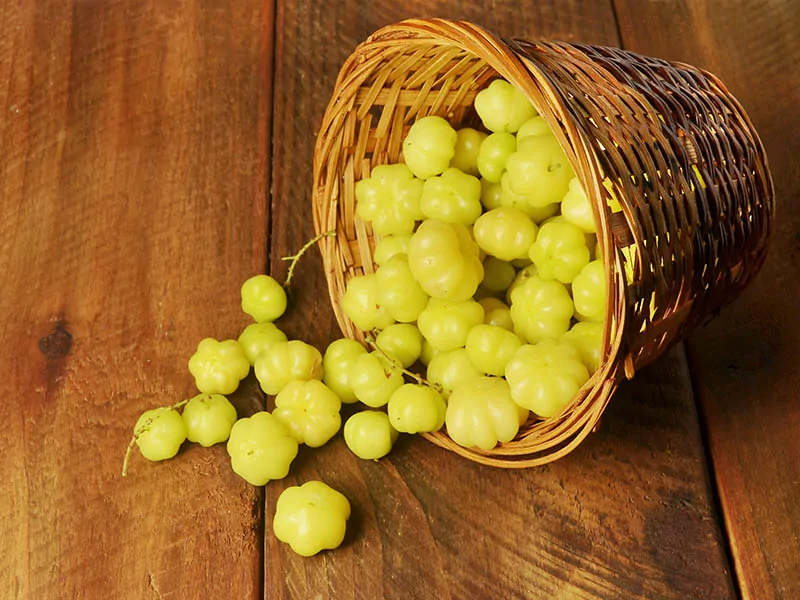
In Jamaica, there are 2 fruits that are called jimbilin, including star fruit and Otaheite gooseberry. In this part, I will introduce the jumbilin version that refers to Otaheite gooseberry. This fruit is a part of the Phyllanthaceae family.
This incredible fruit comes from the Caribbean and South and Central America. Nowadays, you can find it in many parts worldwide. Although it is called “gooseberry”, its appearance is not similar to the gooseberry.
This fruit is small and looks attractive in the yellow or white color. Except for the similarity in the sour taste, Otaheite gooseberries will be juicier and crunchier than standard gooseberries. It has a stone in the middle with about 4 to 6 seeds.
Although this fruit is sour, you can consume it raw. However, it is better to eat this fruit with salt and pepper to reduce acidity. In addition, you cannot miss the preserves and juices made from this fruit in Jamaica.
Nutrients: It includes vitamin C, A, manganese, and calcium.
Season: It is available all year round in Jamaica.
How to eat: You can eat the fruit after rinsing it. You can consume its seeds or remove them, depending on your preference.
28. Breadfruit
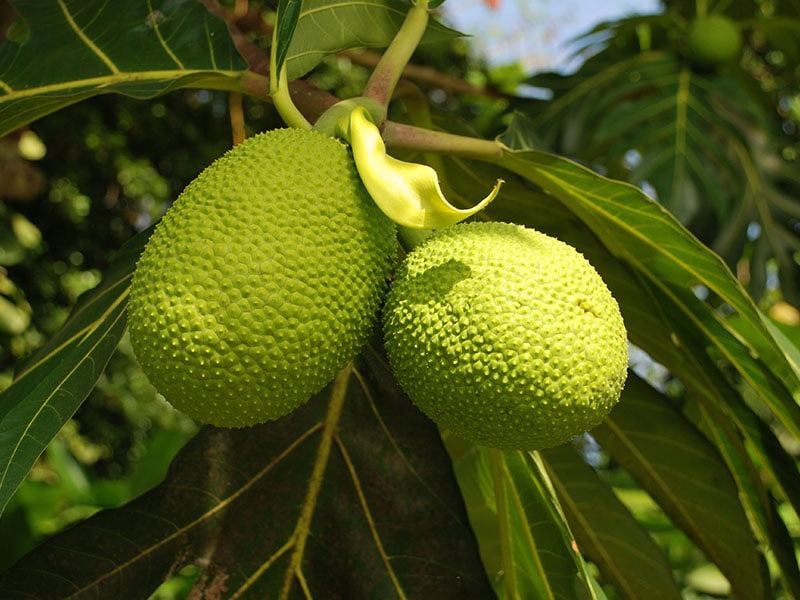
If you want to add many beneficial nutrients to your body, you should not ignore breadfruit. This fruit has its origin in New Guinea, the Philippines, and the Maluku Islands. The seedless type of breadfruit appeared in the Caribbean in the 18th century.
You can find many similarities in appearance between breadfruit and jackfruit because they are in the same family. You can confuse this fruit with jackfruit because it also has thick and green skin with countless small pimples on the surface.
In particular, if you run out of potatoes or bread, you can use breadfruit to substitute for them due to the similarity in texture and flavor.
You can prepare many recipes from breadfruit from boiled, grilled, baked dishes to deep-fried dishes. It is also good to eat overripe breadfruit like the way you eat custard.
Nutrients: Rich in calories, sodium, carbs, fiber, protein, and potassium.
Season: Its season begins in May and finishes in August in Jamaica.
How to eat: Divide the fruit into 2 halves and consume the flesh of this fruit.
Follow the tutorials to consume delicious breadfruit.
29. Noni
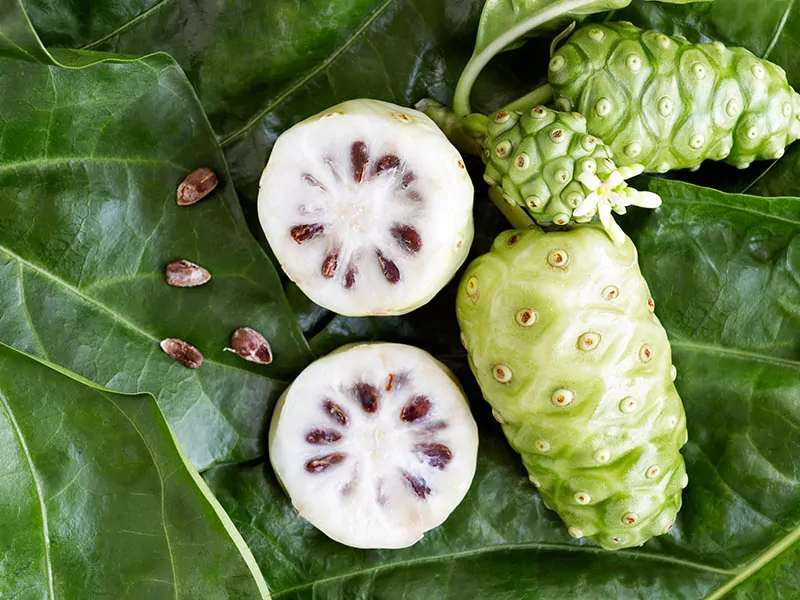
Noni is one of the most exotic fruits in this country. This outstanding fruit is used commonly in South Asia, Hawaii, Latin America, and Central America. Indian mulberry, beach mulberry, and great morinda are the other names of this fruit.
In Jamaica, the volcanic soil is the best condition for the growth of this fruit. People consider it a miracle fruit because it contains many nutrients that are good for healing asthma and cancer. It is used widely in the medical field.
Typically, this fruit has a pale green color and many black spots on the skin surface. Primarily, you might not like its smell because it is similar to vomit odor. Therefore, people rarely consume it as food. So, it also has another nickname, “starvation fruit”.
In Jamaica, people will consume it when they do not have anything to eat. The bitter taste of noni will become better when applied to cooked foods. Of course, you can consume raw noni if you like. You can eat its seeds after toasting.
Nutrients: A rich source of calories, carbs, biotin, folate, and vitamin C.
Season: It is available all year round in Jamaica.
How to eat: Consume the flesh of noni and remove the seeds. You can toast its seeds to eat as a snack.
30. Star Fruit
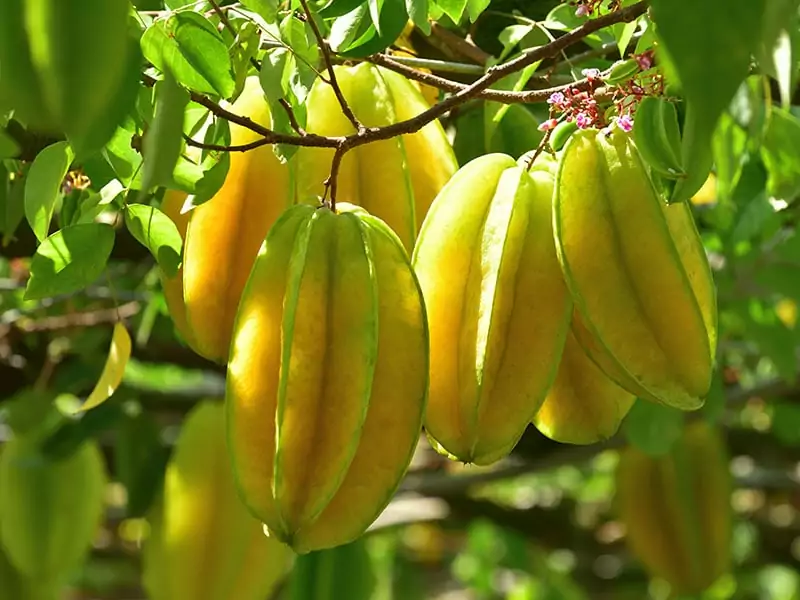
If you love Jamaican-style side dishes like salads, you will love the crunchiness and sour-sweet taste of star fruit, carambola, or five fingers fruit. This fantastic fruit is native to Southeast Asia, and it is also loved widely in Jamaica, Brazil, East Asia, and the Caribbean.
It has a distinctive appearance with five ridges along the sides of the fruit, so when cutting star fruit horizontally, you will have star-like slices. This fruit is covered by a thin, edible, and waxy skin that ranges from light to dark yellow.
Besides the crispness, you will prefer the succulent texture of its flesh. This fruit is a common choice of Jamaicans in making juice, jams, pickles, or smoothies. In addition, it is acceptable to consume raw star fruit.
This fruit is a source of many healthy nutrients. Furthermore, it contains antioxidants that are good for reducing cholesterol levels, fatty liver, and inflammation.
Nutrients: High in fiber, protein, vitamin C, B5, copper, folate, magnesium, and potassium.
Season: This fruit is available from November to March in Jamaica.
How to eat: Consume the whole fruit after washing with water.
31. Coconut
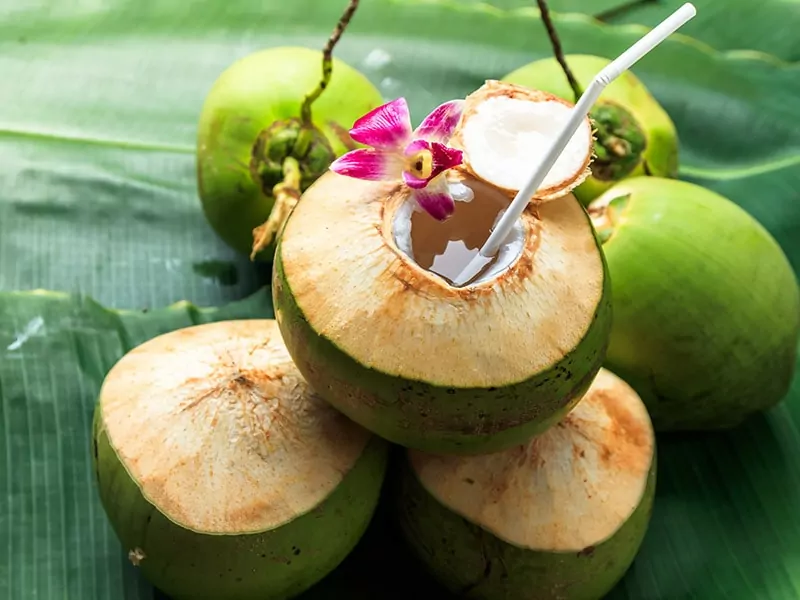
Coconut is a crucial fruit in Jamaican cuisine. People in this country often get water, oil, and milk from this excellent fruit. It is a great experience to enjoy a glass of refreshing and sweet coconut water on summer days in Jamaica.
Coconut comprises 3 layers, including the exocarp, mesocarp, and endocarp. The yellow-green or yellow-brown exocarp layer will protect the fruit. The mesocarp is the combination of various fibers. The exocarp and mesocarp create the husk of the coconut.
The white and creamy flesh of this fruit will be in the endocarp. You can drink the water inside the central cavity of the coconut. In particular, it is safe to enjoy its water at many different stages of coconut maturity.
The meat of coconut will become harder when it matures. Jamaicans often consume it raw or add it to many dishes. In Jamaica, it frequently appeared with rice and peas to create a delicious Jamaican dish.
Nutrients: High in protein, vitamin B, manganese, carbs, and potassium.
Season: It is available all year round in Jamaica.
How to eat: Create a small hole at the end of the fruit to get the water. If you want to use the meat inside, you need to dice the coconut in half and scoop the flesh with a spoon.
Have You Ever Tried Any Jamaican Fruit?
It is an excellent experience to try all of the fruits I have shown in this list. Various fruits are a crucial part of attracting many tourists to Jamaica. You need to take a trip to Jamaica to verify all the information I have mentioned in this article.
If you receive any questions about Jamaican fruits from your friends, let’s show this post to them. After reading this post, if you still have other opinions, please write them down in the comment section, and I will respond as soon as possible. Thanks a lot.
